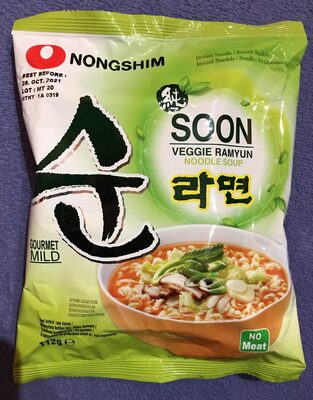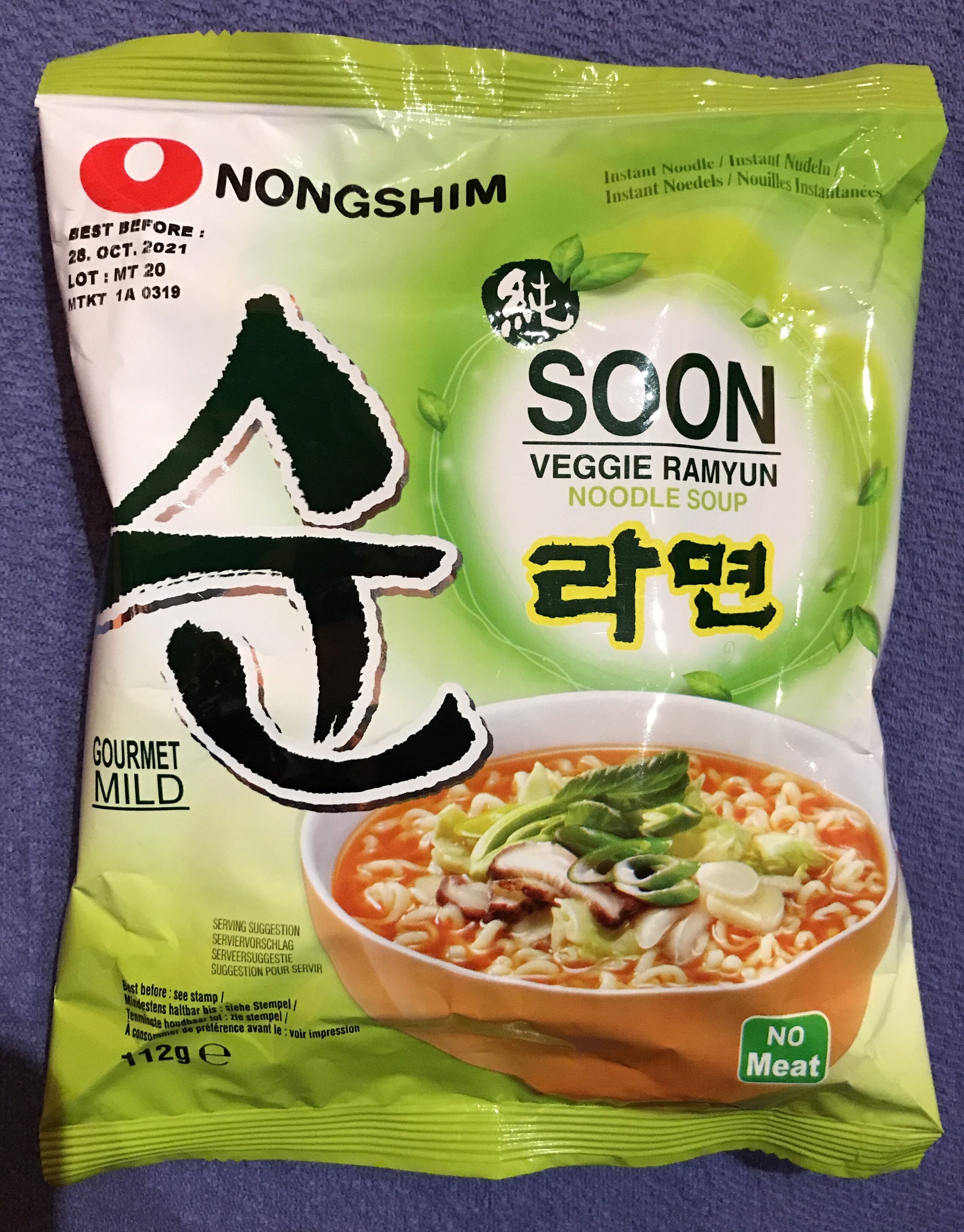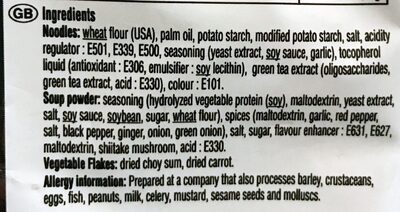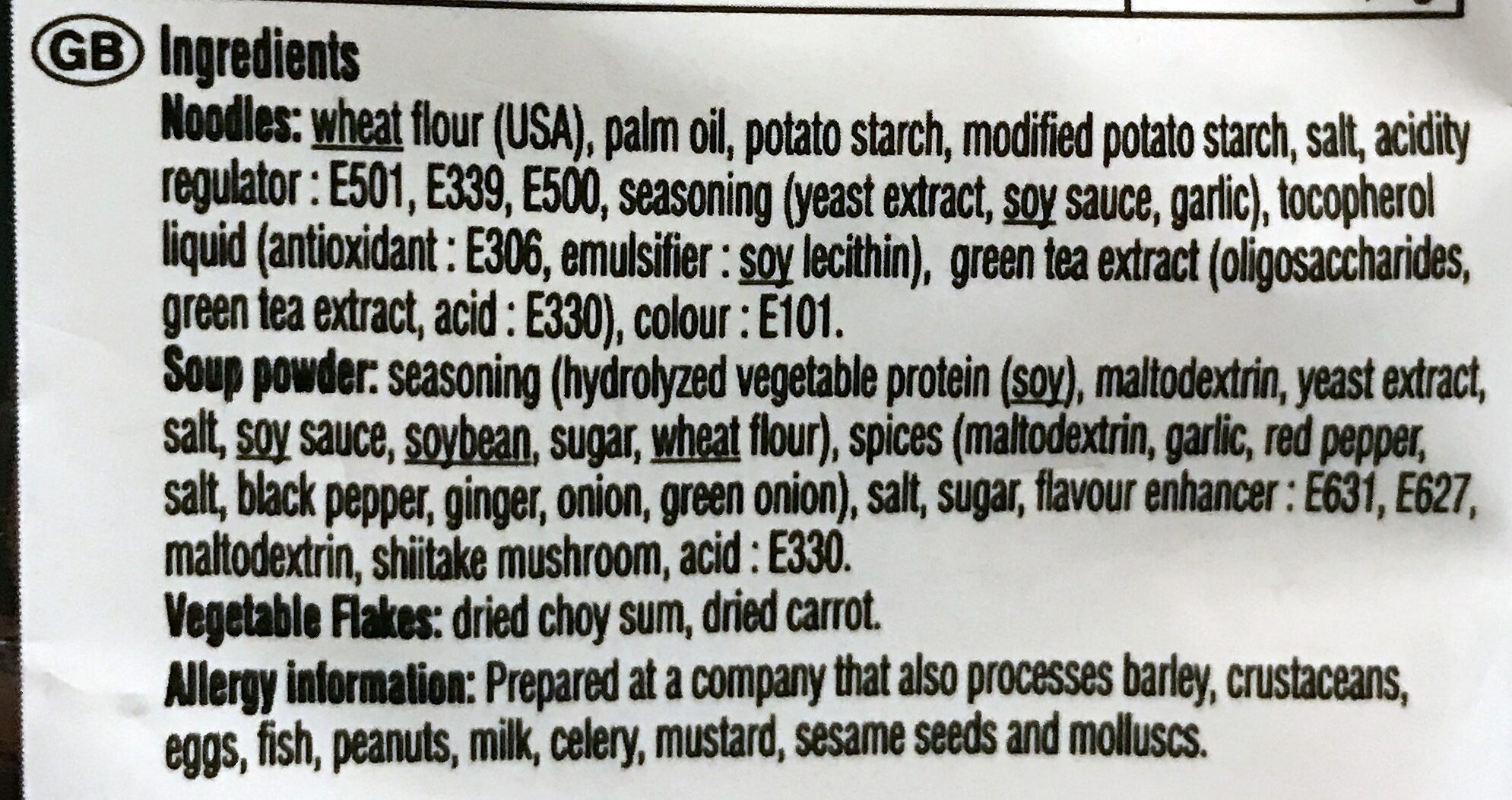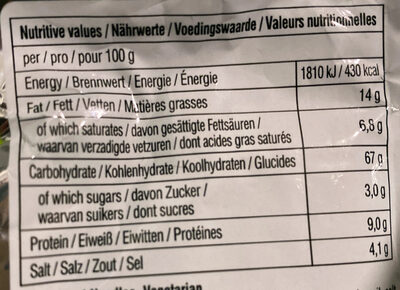Help us make food transparency the norm!
As a non-profit organization, we depend on your donations to continue informing consumers around the world about what they eat.
The food revolution starts with you!
SOON Veggie Ramyun Noodle Soup - Nongshim - 112 g
SOON Veggie Ramyun Noodle Soup - Nongshim - 112 g
Ang pahina ng produkto ay hindi kumpleto. Makakatulong ka sa pagkompleto nito sa pamamagitan ng pag-edit at pagdagdag ng higit pang data mula sa mga larawan na mayroon kami, o sa pamamagitan ng pagkuha ng larawan gamit ang app sa Android or iPhone/iPad. Salamat!
×
Barcode: 8801043022705 (EAN / EAN-13)
Kandidad: 112 g
Balot: en:Plastic, fr:sachet plastique
Mga tatak: Nongshim
Mga kategorya: en:Plant-based foods and beverages, en:Plant-based foods, en:Fruits and vegetables based foods, en:Meals, en:Dried products, Pasta, en:Dried products to be rehydrated, en:Noodles, en:Soups, en:Dried meals, en:Instant noodles, en:Vegetable soups, en:Dehydrated soups, en:Instant noodle soups, en:Dehydrated Asian-style soup with noodles, en:Dehydrated cereals and vegetables soup, en:Dehydrated vegetable soups
Mga tanda, mga sertipikasyon, mga parangal:
en:Vegetarian, Halal, en:Vegan, The Vegan Society, en:Made in Korea, en:No meat, en:Verified

Origin of the product and/or its ingredients: Wheat flour from USA
Pinagmulan ng mga sangkap: Timog Korea
Mga lugar sa paggawa o pagproseso: Seoul, Corea del Sur
Traceability code: 080503010029, 040503190034
Ang link patungo sa pahina ng produkto sa opistal site ng gumawa: https://www.nongshim.com/
Mga Tindahan: supermarché asiatique, Rewe, Tamda, Carrefour, Спар
Mga bansa kung saan ibinebenta: Republikang Tseko, Pransiya, Alemanya, Pilipinas, Rumanya, Rusya, Suwisa
Matching with your preferences
Health
Mga Sangkap
-
55 ingredients
Wikang Ingles: Noodles 89% [wheat flour, palm oil, potato starch, modified potato starch, salt, acidity regulator (E501, E339, E500), seasoning (yeast extract, soy sauce, garlic), tocopherol liquid (antioxidant {E306}, emulsifier {soy lecithin}), green tea extract (oligosaccharides, green tea extract, acid {E330}), colour (E101)], Soup powder 9% [seasoning (hydrolyzed vegetable protein {soy}, maltodextrin, yeast extract, salt, soy sauce, soybean, sugar, wheat flour), spices (maltodextrin, garlic, red pepper, salt, black pepper, ginger, onion, green onion), salt, sugar, flavour enhancer (E631, E627), maltodextrin, shiitake mushroom, acid (E330)], Vegetable Flakes 2% [dried choy sum, dried carrot].Mga allergen: en:Gluten, en:SoybeansMga bakas: en:Celery, en:Crustaceans, en:Eggs, en:Fish, en:Gluten, en:Milk, en:Molluscs, en:Mustard, en:Peanuts, en:Sesame seeds
Food processing
-
Ultra processed foods
Elements that indicate the product is in the en:4 - Ultra processed food and drink products group:
- Sangkap: E101
- Sangkap: E322
- Sangkap: E627
- Sangkap: E631
- Sangkap: Colour
- Sangkap: Emulsifier
- Sangkap: Flavour enhancer
- Sangkap: Maltodextrin
- Sangkap: Sweetener
Food products are classified into 4 groups according to their degree of processing:
- Unprocessed or minimally processed foods
- Processed culinary ingredients
- Processed foods
- Ultra processed foods
The determination of the group is based on the category of the product and on the ingredients it contains.
Mga sangkap
-
E101
Riboflavin: Riboflavin, also known as vitamin B2, is a vitamin found in food and used as a dietary supplement. Food sources include eggs, green vegetables, milk and other dairy product, meat, mushrooms, and almonds. Some countries require its addition to grains. As a supplement it is used to prevent and treat riboflavin deficiency and prevent migraines. It may be given by mouth or injection.It is nearly always well tolerated. Normal doses are safe during pregnancy. Riboflavin is in the vitamin B group. It is required by the body for cellular respiration.Riboflavin was discovered in 1920, isolated in 1933, and first made in 1935. It is on the World Health Organization's List of Essential Medicines, the most effective and safe medicines needed in a health system. Riboflavin is available as a generic medication and over the counter. In the United States a month of supplements costs less than 25 USD.Source: Wikipedia (Wikang Ingles)
-
E322
Lecithin: Lecithin -UK: , US: , from the Greek lekithos, "egg yolk"- is a generic term to designate any group of yellow-brownish fatty substances occurring in animal and plant tissues, which are amphiphilic – they attract both water and fatty substances -and so are both hydrophilic and lipophilic-, and are used for smoothing food textures, dissolving powders -emulsifying-, homogenizing liquid mixtures, and repelling sticking materials.Lecithins are mixtures of glycerophospholipids including phosphatidylcholine, phosphatidylethanolamine, phosphatidylinositol, phosphatidylserine, and phosphatidic acid.Lecithin was first isolated in 1845 by the French chemist and pharmacist Theodore Gobley. In 1850, he named the phosphatidylcholine lécithine. Gobley originally isolated lecithin from egg yolk—λέκιθος lekithos is "egg yolk" in Ancient Greek—and established the complete chemical formula of phosphatidylcholine in 1874; in between, he had demonstrated the presence of lecithin in a variety of biological matters, including venous blood, in human lungs, bile, human brain tissue, fish eggs, fish roe, and chicken and sheep brain. Lecithin can easily be extracted chemically using solvents such as hexane, ethanol, acetone, petroleum ether, benzene, etc., or extraction can be done mechanically. It is usually available from sources such as soybeans, eggs, milk, marine sources, rapeseed, cottonseed, and sunflower. It has low solubility in water, but is an excellent emulsifier. In aqueous solution, its phospholipids can form either liposomes, bilayer sheets, micelles, or lamellar structures, depending on hydration and temperature. This results in a type of surfactant that usually is classified as amphipathic. Lecithin is sold as a food additive and dietary supplement. In cooking, it is sometimes used as an emulsifier and to prevent sticking, for example in nonstick cooking spray.Source: Wikipedia (Wikang Ingles)
-
E322i
Lecithin: Lecithin -UK: , US: , from the Greek lekithos, "egg yolk"- is a generic term to designate any group of yellow-brownish fatty substances occurring in animal and plant tissues, which are amphiphilic – they attract both water and fatty substances -and so are both hydrophilic and lipophilic-, and are used for smoothing food textures, dissolving powders -emulsifying-, homogenizing liquid mixtures, and repelling sticking materials.Lecithins are mixtures of glycerophospholipids including phosphatidylcholine, phosphatidylethanolamine, phosphatidylinositol, phosphatidylserine, and phosphatidic acid.Lecithin was first isolated in 1845 by the French chemist and pharmacist Theodore Gobley. In 1850, he named the phosphatidylcholine lécithine. Gobley originally isolated lecithin from egg yolk—λέκιθος lekithos is "egg yolk" in Ancient Greek—and established the complete chemical formula of phosphatidylcholine in 1874; in between, he had demonstrated the presence of lecithin in a variety of biological matters, including venous blood, in human lungs, bile, human brain tissue, fish eggs, fish roe, and chicken and sheep brain. Lecithin can easily be extracted chemically using solvents such as hexane, ethanol, acetone, petroleum ether, benzene, etc., or extraction can be done mechanically. It is usually available from sources such as soybeans, eggs, milk, marine sources, rapeseed, cottonseed, and sunflower. It has low solubility in water, but is an excellent emulsifier. In aqueous solution, its phospholipids can form either liposomes, bilayer sheets, micelles, or lamellar structures, depending on hydration and temperature. This results in a type of surfactant that usually is classified as amphipathic. Lecithin is sold as a food additive and dietary supplement. In cooking, it is sometimes used as an emulsifier and to prevent sticking, for example in nonstick cooking spray.Source: Wikipedia (Wikang Ingles)
-
E330
Citric acid: Citric acid is a weak organic acid that has the chemical formula C6H8O7. It occurs naturally in citrus fruits. In biochemistry, it is an intermediate in the citric acid cycle, which occurs in the metabolism of all aerobic organisms. More than a million tons of citric acid are manufactured every year. It is used widely as an acidifier, as a flavoring and chelating agent.A citrate is a derivative of citric acid; that is, the salts, esters, and the polyatomic anion found in solution. An example of the former, a salt is trisodium citrate; an ester is triethyl citrate. When part of a salt, the formula of the citrate ion is written as C6H5O3−7 or C3H5O-COO-3−3.Source: Wikipedia (Wikang Ingles)
-
E339
Sodium phosphates: Sodium phosphate is a generic term for a variety of salts of sodium -Na+- and phosphate -PO43−-. Phosphate also forms families or condensed anions including di-, tri-, tetra-, and polyphosphates. Most of these salts are known in both anhydrous -water-free- and hydrated forms. The hydrates are more common than the anhydrous forms.Source: Wikipedia (Wikang Ingles)
-
E500
Sodium carbonate: Sodium carbonate, Na2CO3, -also known as washing soda, soda ash and soda crystals, and in the monohydrate form as crystal carbonate- is the water-soluble sodium salt of carbonic acid. It most commonly occurs as a crystalline decahydrate, which readily effloresces to form a white powder, the monohydrate. Pure sodium carbonate is a white, odorless powder that is hygroscopic -absorbs moisture from the air-. It has a strongly alkaline taste, and forms a moderately basic solution in water. Sodium carbonate is well known domestically for its everyday use as a water softener. Historically it was extracted from the ashes of plants growing in sodium-rich soils, such as vegetation from the Middle East, kelp from Scotland and seaweed from Spain. Because the ashes of these sodium-rich plants were noticeably different from ashes of timber -used to create potash-, they became known as "soda ash". It is synthetically produced in large quantities from salt -sodium chloride- and limestone by a method known as the Solvay process. The manufacture of glass is one of the most important uses of sodium carbonate. Sodium carbonate acts as a flux for silica, lowering the melting point of the mixture to something achievable without special materials. This "soda glass" is mildly water-soluble, so some calcium carbonate is added to the melt mixture to make the glass produced insoluble. This type of glass is known as soda lime glass: "soda" for the sodium carbonate and "lime" for the calcium carbonate. Soda lime glass has been the most common form of glass for centuries. Sodium carbonate is also used as a relatively strong base in various settings. For example, it is used as a pH regulator to maintain stable alkaline conditions necessary for the action of the majority of photographic film developing agents. It acts as an alkali because when dissolved in water, it dissociates into the weak acid: carbonic acid and the strong alkali: sodium hydroxide. This gives sodium carbonate in solution the ability to attack metals such as aluminium with the release of hydrogen gas.It is a common additive in swimming pools used to raise the pH which can be lowered by chlorine tablets and other additives which contain acids. In cooking, it is sometimes used in place of sodium hydroxide for lyeing, especially with German pretzels and lye rolls. These dishes are treated with a solution of an alkaline substance to change the pH of the surface of the food and improve browning. In taxidermy, sodium carbonate added to boiling water will remove flesh from the bones of animal carcasses for trophy mounting or educational display. In chemistry, it is often used as an electrolyte. Electrolytes are usually salt-based, and sodium carbonate acts as a very good conductor in the process of electrolysis. In addition, unlike chloride ions, which form chlorine gas, carbonate ions are not corrosive to the anodes. It is also used as a primary standard for acid-base titrations because it is solid and air-stable, making it easy to weigh accurately.Source: Wikipedia (Wikang Ingles)
-
E501
Potassium carbonate: Potassium carbonate -K2CO3- is a white salt, which is soluble in water -insoluble in ethanol- and forms a strongly alkaline solution. It can be made as the product of potassium hydroxide's absorbent reaction with carbon dioxide. It is deliquescent, often appearing a damp or wet solid. Potassium carbonate is used in the production of soap and glass.Source: Wikipedia (Wikang Ingles)
-
E627
Disodium guanylate: Disodium guanylate, also known as sodium 5'-guanylate and disodium 5'-guanylate, is a natural sodium salt of the flavor enhancing nucleotide guanosine monophosphate -GMP-. Disodium guanylate is a food additive with the E number E627. It is commonly used in conjunction with glutamic acid. As it is a fairly expensive additive, it is not used independently of glutamic acid; if disodium guanylate is present in a list of ingredients but MSG does not appear to be, it is likely that glutamic acid is provided as part of another ingredient such as a processed soy protein complex. It is often added to foods in conjunction with disodium inosinate; the combination is known as disodium 5'-ribonucleotides. Disodium guanylate is produced from dried seaweed and is often added to instant noodles, potato chips and other snacks, savory rice, tinned vegetables, cured meats, and packaged soup.Source: Wikipedia (Wikang Ingles)
-
E631
Disodium inosinate: Disodium inosinate -E631- is the disodium salt of inosinic acid with the chemical formula C10H11N4Na2O8P. It is used as a food additive and often found in instant noodles, potato chips, and a variety of other snacks. Although it can be obtained from bacterial fermentation of sugars, it is often commercially prepared from animal sources.Source: Wikipedia (Wikang Ingles)
Pagsusuri ng sangkap
-
en:Palm oil
Ingredients that contain palm oil: en:Palm oil
-
en:Vegan
No non-vegan ingredients
Unrecognized ingredients: en:Vitamin E, en:Oligosaccharides, en:soup-powder, en:dried-choy-sumSome ingredients could not be recognized.
We need your help!
You can help us recognize more ingredients and better analyze the list of ingredients for this product and others:
- Edit this product page to correct spelling mistakes in the ingredients list, and/or to remove ingredients in other languages and sentences that are not related to the ingredients.
- Add new entries, synonyms or translations to our multilingual lists of ingredients, ingredient processing methods, and labels.
If you would like to help, join the #ingredients channel on our Slack discussion space and/or learn about ingredients analysis on our wiki. Thank you!
-
en:Vegetarian
No non-vegetarian ingredients detected
Unrecognized ingredients: en:Vitamin E, en:Oligosaccharides, en:soup-powder, en:dried-choy-sumSome ingredients could not be recognized.
We need your help!
You can help us recognize more ingredients and better analyze the list of ingredients for this product and others:
- Edit this product page to correct spelling mistakes in the ingredients list, and/or to remove ingredients in other languages and sentences that are not related to the ingredients.
- Add new entries, synonyms or translations to our multilingual lists of ingredients, ingredient processing methods, and labels.
If you would like to help, join the #ingredients channel on our Slack discussion space and/or learn about ingredients analysis on our wiki. Thank you!
-
Details of the analysis of the ingredients
We need your help!
Some ingredients could not be recognized.
We need your help!
You can help us recognize more ingredients and better analyze the list of ingredients for this product and others:
- Edit this product page to correct spelling mistakes in the ingredients list, and/or to remove ingredients in other languages and sentences that are not related to the ingredients.
- Add new entries, synonyms or translations to our multilingual lists of ingredients, ingredient processing methods, and labels.
If you would like to help, join the #ingredients channel on our Slack discussion space and/or learn about ingredients analysis on our wiki. Thank you!
en: Noodles 89% (wheat flour, palm oil, potato starch, modified potato starch, salt, acidity regulator (e501, e339, e500), seasoning (yeast extract, soy sauce, garlic), tocopherol (antioxidant (), emulsifier (soy lecithin)), green tea extract (oligosaccharides, green tea extract, acid ()), colour (e101)), Soup powder 9% (seasoning (hydrolyzed vegetable protein, maltodextrin, yeast extract, salt, soy sauce, soybean, sugar, wheat flour), spices (maltodextrin, garlic, red pepper, salt, black pepper, ginger, onion, green onion), salt, sugar, flavour enhancer (e631, e627), maltodextrin, shiitake mushroom, acid (e330)), Vegetable 2% (dried choy sum, dried carrot)- Noodles -> en:noodle - vegan: maybe - vegetarian: maybe - percent_min: 89 - percent: 89 - percent_max: 89
- wheat flour -> en:wheat-flour - vegan: yes - vegetarian: yes - ciqual_proxy_food_code: 9410 - percent_min: 8.9 - percent_max: 89
- palm oil -> en:palm-oil - vegan: yes - vegetarian: yes - from_palm_oil: yes - ciqual_food_code: 16129 - percent_min: 0 - percent_max: 44.5
- potato starch -> en:potato-starch - vegan: yes - vegetarian: yes - ciqual_proxy_food_code: 9510 - percent_min: 0 - percent_max: 29.6666666666667
- modified potato starch -> en:modified-potato-starch - vegan: yes - vegetarian: yes - ciqual_proxy_food_code: 9510 - percent_min: 0 - percent_max: 22.25
- salt -> en:salt - vegan: yes - vegetarian: yes - ciqual_food_code: 11058 - percent_min: 0 - percent_max: 4.1
- acidity regulator -> en:acidity-regulator - percent_min: 0 - percent_max: 4.1
- e501 -> en:e501 - vegan: yes - vegetarian: yes - percent_min: 0 - percent_max: 4.1
- e339 -> en:e339 - vegan: yes - vegetarian: yes - percent_min: 0 - percent_max: 2.05
- e500 -> en:e500 - vegan: yes - vegetarian: yes - percent_min: 0 - percent_max: 1.36666666666667
- seasoning -> en:coating - vegan: maybe - vegetarian: maybe - percent_min: 0 - percent_max: 4.1
- yeast extract -> en:yeast-extract - vegan: yes - vegetarian: yes - percent_min: 0 - percent_max: 4.1
- soy sauce -> en:soy-sauce - vegan: maybe - vegetarian: maybe - ciqual_food_code: 11104 - percent_min: 0 - percent_max: 2.05
- garlic -> en:garlic - vegan: yes - vegetarian: yes - ciqual_food_code: 11000 - percent_min: 0 - percent_max: 1.36666666666667
- tocopherol -> en:vitamin-e - percent_min: 0 - percent_max: 0
- antioxidant -> en:antioxidant - percent_min: 0 - percent_max: 0
- emulsifier -> en:emulsifier - percent_min: 0 - percent_max: 0
- soy lecithin -> en:soya-lecithin - vegan: yes - vegetarian: yes - ciqual_food_code: 42200 - percent_min: 0 - percent_max: 0
- antioxidant -> en:antioxidant - percent_min: 0 - percent_max: 0
- green tea extract -> en:green-tea-extract - vegan: yes - vegetarian: yes - ciqual_food_code: 18155 - percent_min: 0 - percent_max: 0
- oligosaccharides -> en:oligosaccharides - percent_min: 0 - percent_max: 0
- green tea extract -> en:green-tea-extract - vegan: yes - vegetarian: yes - ciqual_food_code: 18155 - percent_min: 0 - percent_max: 0
- acid -> en:acid - percent_min: 0 - percent_max: 0
- colour -> en:colour - percent_min: 0 - percent_max: 0
- e101 -> en:e101 - vegan: maybe - vegetarian: yes - percent_min: 0 - percent_max: 0
- Soup powder -> en:soup-powder - percent_min: 9 - percent: 9 - percent_max: 9
- seasoning -> en:coating - vegan: maybe - vegetarian: maybe - percent_min: 1.125 - percent_max: 9
- hydrolyzed vegetable protein -> en:hydrolysed-vegetable-protein - vegan: yes - vegetarian: yes - percent_min: 0.140625 - percent_max: 9
- maltodextrin -> en:maltodextrin - vegan: yes - vegetarian: yes - percent_min: 0 - percent_max: 4.5
- yeast extract -> en:yeast-extract - vegan: yes - vegetarian: yes - percent_min: 0 - percent_max: 3
- salt -> en:salt - vegan: yes - vegetarian: yes - ciqual_food_code: 11058 - percent_min: 0 - percent_max: 2.25
- soy sauce -> en:soy-sauce - vegan: maybe - vegetarian: maybe - ciqual_food_code: 11104 - percent_min: 0 - percent_max: 1.8
- soybean -> en:soya-bean - vegan: yes - vegetarian: yes - ciqual_food_code: 20901 - percent_min: 0 - percent_max: 1.5
- sugar -> en:sugar - vegan: yes - vegetarian: yes - ciqual_proxy_food_code: 31016 - percent_min: 0 - percent_max: 1.28571428571429
- wheat flour -> en:wheat-flour - vegan: yes - vegetarian: yes - ciqual_proxy_food_code: 9410 - percent_min: 0 - percent_max: 1.125
- spices -> en:spice - vegan: yes - vegetarian: yes - percent_min: 0 - percent_max: 4.5
- maltodextrin -> en:maltodextrin - vegan: yes - vegetarian: yes - percent_min: 0 - percent_max: 4.5
- garlic -> en:garlic - vegan: yes - vegetarian: yes - ciqual_food_code: 11000 - percent_min: 0 - percent_max: 2.25
- red pepper -> en:red-bell-pepper - vegan: yes - vegetarian: yes - ciqual_food_code: 20087 - percent_min: 0 - percent_max: 1.5
- salt -> en:salt - vegan: yes - vegetarian: yes - ciqual_food_code: 11058 - percent_min: 0 - percent_max: 1.125
- black pepper -> en:black-pepper - vegan: yes - vegetarian: yes - ciqual_food_code: 11015 - percent_min: 0 - percent_max: 0.9
- ginger -> en:ginger - vegan: yes - vegetarian: yes - ciqual_food_code: 11074 - percent_min: 0 - percent_max: 0.75
- onion -> en:onion - vegan: yes - vegetarian: yes - ciqual_food_code: 20034 - percent_min: 0 - percent_max: 0.642857142857143
- green onion -> en:spring-onion - vegan: yes - vegetarian: yes - ciqual_food_code: 11003 - percent_min: 0 - percent_max: 0.5625
- salt -> en:salt - vegan: yes - vegetarian: yes - ciqual_food_code: 11058 - percent_min: 0 - percent_max: 3
- sugar -> en:sugar - vegan: yes - vegetarian: yes - ciqual_proxy_food_code: 31016 - percent_min: 0 - percent_max: 2.25
- flavour enhancer -> en:flavour-enhancer - percent_min: 0 - percent_max: 1.8
- e631 -> en:e631 - vegan: maybe - vegetarian: maybe - percent_min: 0 - percent_max: 1.8
- e627 -> en:e627 - vegan: maybe - vegetarian: maybe - percent_min: 0 - percent_max: 0.9
- maltodextrin -> en:maltodextrin - vegan: yes - vegetarian: yes - percent_min: 0 - percent_max: 1.5
- shiitake mushroom -> en:shiitake - vegan: yes - vegetarian: yes - ciqual_food_code: 20010 - percent_min: 0 - percent_max: 1.28571428571429
- acid -> en:acid - percent_min: 0 - percent_max: 1.125
- e330 -> en:e330 - vegan: yes - vegetarian: yes - percent_min: 0 - percent_max: 1.125
- seasoning -> en:coating - vegan: maybe - vegetarian: maybe - percent_min: 1.125 - percent_max: 9
- Vegetable -> en:vegetable - vegan: yes - vegetarian: yes - percent_min: 2 - percent: 2 - percent_max: 2
- dried choy sum -> en:dried-choy-sum - percent_min: 1 - percent_max: 2
- dried carrot -> en:dried-carrot - vegan: yes - vegetarian: yes - ciqual_food_code: 20009 - percent_min: 0 - percent_max: 1
- Wheat flour from USA
Wheat flour -> en:wheat-flour
-
Mga katotohanan ng Nutrisyon
Mga katotohanan ng Nutrisyon As sold
para sa 100 g / 100 mlAs sold
bawat serving (112 g)Compared to: en:Meals Enerhiya 1,810 kj
(430 kcal)2,030 kj
(482 kcal)+282% Fat 14 g 15.7 g +286% Saturated fat 6.8 g 7.62 g Carbohydrates 67 g 75 g +359% Asukal 3 g 3.36 g Fiber - - Protina 9 g 10.1 g +92% Asin 4.1 g 4.59 g Alcohol - - Fruits‚ vegetables‚ nuts and rapeseed‚ walnut and olive oils (estimate from ingredients list analysis) 3.092 % 3.092 %
Kapaligiran
-
Eco-Score B - Low environmental impact
⚠ ️The full impact of transportation to your country is currently unknown.The Eco-Score is an experimental score that summarizes the environmental impacts of food products.→ The Eco-Score was initially developped for France and it is being extended to other European countries. The Eco-Score formula is subject to change as it is regularly improved to make it more precise and better suited to each country.Life cycle analysis
-
Average impact of products of the same category: A (Score: 96/100)
Kategorya: Soup, cereals and vegetables, dehydrated and reconstituted
Kategorya: Soup, cereals and vegetables, dehydrated and reconstituted
- PEF environmental score: 0.13 (the lower the score, the lower the impact)
- including impact on climate change: 0.54 kg CO2 eq/kg of product
Stage Impact Agriculture
22.4 %Processing
70.6 %Balot
0.4 %Transportation
2.9 %Distribution
0.2 %Consumption
3.5 %
Bonuses and maluses
-
Origins of ingredients with a high impact
Malus:
Environmental policy: +1
Transportation: 0
Origin of the product and/or its ingredients % of ingredients Impact Timog Korea 51 %Medium Estados Unidos 49 %Medium
-
Ingredients that threatens species
Malus: -10
Contains palm oil
Tropical forests in Asia, Africa and Latin America are destroyed to create and expand oil palm tree plantations. The deforestation contributes to climate change, and it endangers species such as the orangutan, the pigmy elephant and the Sumatran rhino.
-
Packaging with a medium impact
Malus: -10
Shape Material Recycling Impact 1 Bag Plastic Mataas
Eco-Score for this product
-
Impact for this product: B (Score: 77/100)
Produkto: SOON Veggie Ramyun Noodle Soup - Nongshim - 112 g
Life cycle analysis score: 96
Sum of bonuses and maluses: -20
Final score: 77/100
-
Carbon footprint
-
Equal to driving 0.3 km in a petrol car
54 g CO² per 100g of product
The carbon emission figure comes from ADEME's Agribalyse database, for the category: Soup, cereals and vegetables, dehydrated and reconstituted (Source: ADEME Agribalyse Database)
Stage Impact Agriculture
24.9 %Processing
64.2 %Balot
1.0 %Transportation
7.6 %Distribution
0.2 %Consumption
2.1 %
Balot
-
Packaging with a medium impact
-
Packaging parts
1 x Bag (Plastic)
-
Packaging materials
Material % Packaging weight Packaging weight per 100 g of product Plastic
-
Transportation
-
Origins of ingredients
Origins of ingredients with a high impact
Origin of the product and/or its ingredients % of ingredients Impact Timog Korea 51 %Medium Estados Unidos 49 %Medium
Threatened species
-
Contains palm oil
Drives deforestation and threatens species such as the orangutan
Tropical forests in Asia, Africa and Latin America are destroyed to create and expand oil palm tree plantations. The deforestation contributes to climate change, and it endangers species such as the orangutan, the pigmy elephant and the Sumatran rhino.
Report a problem
-
Incomplete or incorrect information?
Category, labels, ingredients, allergens, nutritional information, photos etc.
If the information does not match the information on the packaging, please complete or correct it. Open Food Facts is a collaborative database, and every contribution is useful for all.
Data sources
Produkto idinagdag sa sa pamamagitan ng openfood-ch-import
Huling pag-edit ng pahina ng produkto sa pamamagitan ng 5m4u9.
Pahina ng produkto ay na-edit din ni aleene, antoniojr, baitmooth, bessheron, date-limite-app, foodrepo, harragastudios, inf, kiliweb, openfoodfacts-contributors, packbot, planteuser, risajanda, roboto-app, rotebete, scanbot, silver-wolf, smoothie-app, tacite-mass-editor, yuka.AIJiF9qHHeYDEvrOgLwFxxqVLf7rA9l_AlEuog.
